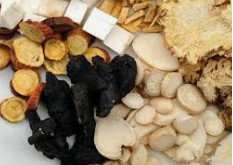Effects of Different Drying Methods on Main Chemical Components in Polygala tenuifolia Tube and Root

ABSTRACT: OBJECTIVE To investigate the effects of five drying methods, i.e. sun drying, shade drying, hot air drying (40, 50, 60, 70 C), microwave drying and freeze drying, on the main chemical constituents of Polygala tenuifolia and its roots. METHODS The components and contents of polygalone III, 3,6'-dimustinoyl sucrose, polygallic acid, polygalactoside and polygalactoside in Polygala tenuifolia were determined by HPLC with different drying methods. The data were analyzed by one-way ANOVA and TOPSIS.
Result There were differences in the optimum order of drying methods between Radix Polygalae and its roots. The order of the effects of different drying methods on the active ingredients was Microwave Drying Equipment > 60 C hot air drying > 50 C hot air drying > 70 C hot air drying > freeze drying > 40 C hot air drying > shade drying > sun drying. In Radix Polygalae, the order of different drying methods was microwave drying > 60 C hot air drying > freeze drying. Shade drying > sun drying > 50 C hot air drying > 40 C hot air drying > 70 C hot air drying > freeze drying.
CONCLUSION: Microwave drying and 60 C hot air drying are suitable drying methods for Radix Polygalae tubers and roots, which can provide basis for the determination of drying methods for different specifications of Radix Polygalae.

Key words: Polygala tenuifolia; drying method; polygalone III; 3,6'-dimustard acyl sucrose; polygallic acid; Polygala saponin; Polygala tenuifolia saponin; microwave drying of traditional Chinese medicine
Polygala tenuifolia is the dry root of Polygala tenuifolia or Polygala tenuifolia. It is one of the most commonly used Chinese herbal medicines in China. It has the functions of soothing mind, improving mind, communicating heart and kidney, eliminating phlegm and detumescence. Modern Chinese medicine research shows that the main chemical constituents of Polygala tenuifolia are saponins, ketones, oligosaccharides, alkaloids, polysaccharides, flavonoids, etc. It has the pharmacological effects of sedation, anti-convulsion, anti-depression, anti-myocardial ischemia and enhancing learning and memory. Clinically, it is mostly used for insomnia, dreaminess, forgetfulness, palpitation, trance, sputum discomfort, sores and sores, swelling and pain of breast caused by heart and kidney disjunction.
The dried roots of Polygala tenuifolia and Polygala willowii were collected in the Chinese Pharmacopoeia 2015 edition. The quality of Polygala tenuifolia saponins (> 2.0%), Polygalone III and 3,6'-dimustard acyl sucrose (> 0.5%) were used as the criteria to evaluate the internal quality of Polygala tenuifolia.
At present, the commercial medicinal materials of Polygala tenuifolia in the market are mainly divided into three specifications: Polygala tenuifolia barrel, Polygala tenuifolia meat and Polygala tenuifolia stick according to whether cores are extracted from the original processing. When the skin is slightly wrinkled and the cores are removed by hand rubbing and drying, the cores are Yuanzhi cans; if the cores can not be removed, Yuanzhi cans are used to cut the cores, and Yuanzhi cans are used to remove the cores; if the cores are small and the cores can not be removed or not, Yuanzhi cans are considered to be the best of the three specifications, and the price is the highest.
The drying method is one of the key factors in the quality formation of medicinal materials. The suitable drying method is beneficial to the storage and effective ingredient retention of medicinal materials, such as hot air drying, microwave drying, freeze-drying, infrared drying, etc. It has the characteristics of controllable parameters, short drying time and stable quality of medicinal materials. It has been used in the processing of many kinds of medicinal materials.
At present, the primary processing of Polygala tenuifolia is mostly sun-dried, and the research on different drying methods of Polygala tenuifolia has not been reported. In view of this, in order to better evaluate the effect of different drying methods on the quality of Polygala tenuifolia, this study used sun drying, shade drying, hot air drying (40, 50, 60, 70 C), microwave drying and freeze drying to process Polygala tenuifolia, Polygala tenuifolia root and Polygala tenuifolia. The contents of polygalone III, 3,6'-disinoacyl sucrose, polygallic acid, Polygala saponin and Polygala tenuifolia saponin were determined. In order to provide scientific basis for improving drying methods of different specifications of Polygala tenuifolia after harvesting.